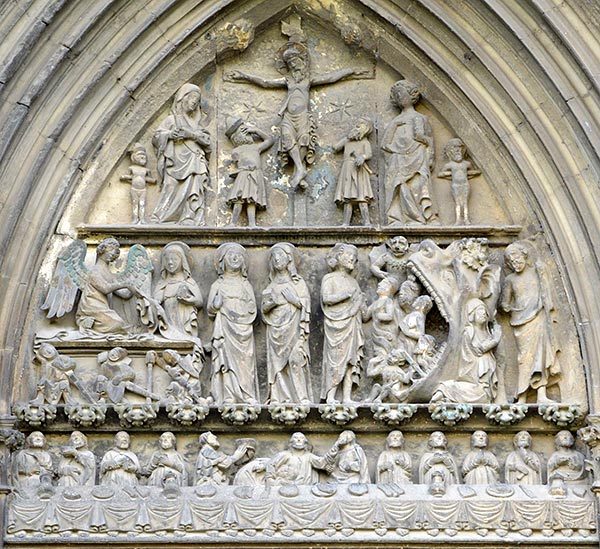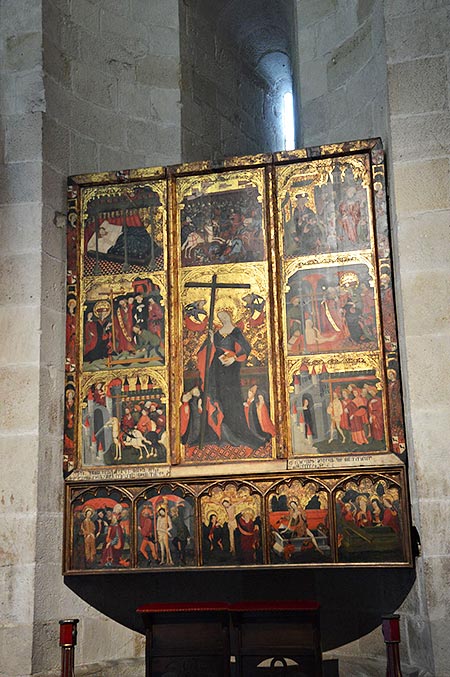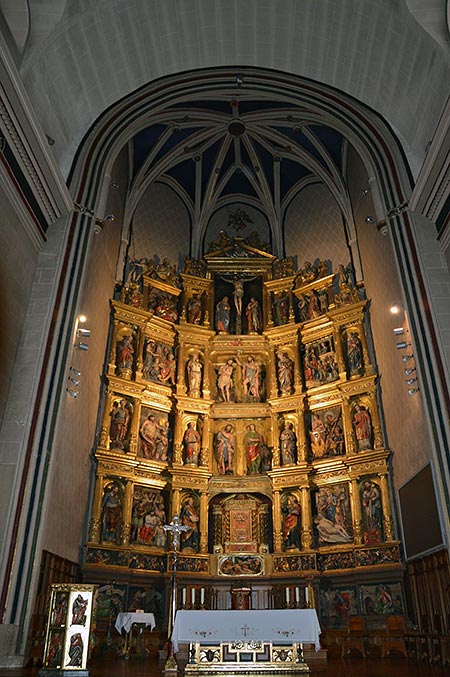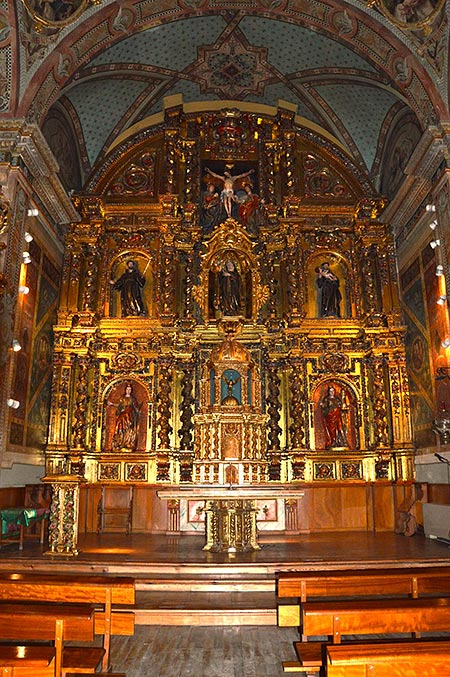October 20
Religious heritage in Estella. Images and their supports:
covers and altarpieces
Alejandro Aranda Ruiz
Cultural Heritage. Archbishopric of Pamplona and Tudela.
The city of Estella has an abundant and rich religious heritage treasured over the centuries, from some of its parish churches built in the late thirteenth century, to the Basilica of Our Lady of El Puy, built in the mid-twentieth century. Given the impossibility of addressing all this in a lecture, we propose a short walk through a series of works that allow us an overview of what is the religious heritage of Estella from the Age average to the Baroque without choking along the way.
The guiding thread of this walk will be the role played by images in the religious sphere, which will lead us to talk about images and their supports, covers and altarpieces.
The dual use and function of images in the religious sphere
Images play a crucial role in the religious sphere, performing a double function. On the one hand, they give body to ideas and concepts, and on the other, they materialize and make palpable celestial realities. Consequently, the function of images is both catechetical and cultic or devotional.
We are therefore confronted with images destined to form the faithful in Christian doctrine and in the principal truths of faith. Preaching will be an essential complement to these images, since the preacher will often make use of them to explain concepts or episodes in the life of Christ, the Virgin and the saints. The unlettered people will have in the images their bible, their principal means of training. The final goal of this training will be to orient the conduct of the faithful people in a certain direction. In the lives of the saints the people will find examples of Christian conduct, in the glory of heaven they will see the eternal award that God promises to those who are faithful to him, as well as in the representations of hell, of sins and their punishments, they will see the consequences of a conduct far from the precepts of God.
But, on the other hand, the images will be objects of worship and devotion, making the invisible visible, per visibilia ad invisibilia. Faced with the sporadic iconoclastic temptations of some sectors, the Church will defend the lawfulness of the cult of images and their role in the training and evangelization of the people in repeated councils, as in the II of Nicaea in 787 and, above all, in the 25th session of the Council of Trent (1545-1563), which will approve a decree on images and the cult of saints and relics that summarizes the entire Catholic doctrine in this regard. This doctrine makes reference letter to the double nature of the images as means of evangelization and objects of worship.
This double function of the images is what we are going to see next through the covers and the altarpieces. The former are a good example of the instructive function of the images, and the latter, of their liturgical or devotional character.
Covers: images as evangelization tool
One of the favorite places of the monumental sculpture will be the doorways, which frame the place of access to the temple, a place of obligatory passage for everyone who goes in and out of the church. Likewise, the doorways open onto the public road and are visible to all, so that it is not necessary to enter the church to contemplate them. In this way, the doorway is, so to speak, a cover letter of the temple in which it is located. It would be like the window of a current store or a billboard, since a cover tells us things about the temple in which it is framed (who is its owner, for example), tells us about its promoter or promoters (what devotions he had, what message or idea he wanted to convey by commissioning the cover) and informs us about the religiosity and mentality of the time in which it was built (how the divinity was conceived or what teachings the Church emphasized more). Therefore, the covers are going to be a powerful tool of catechesis and evangelization.
Good examples of this can be found in the doorway of San Miguel, sculpted around 1170-1180, whose iconographic program is particularly suited to the context of a city with a great deal of movement of people, as a result of the Camino de Santiago, and with the presence of significant minorities of Jews and Muslims, and in the doorway of the Holy Sepulchre, erected in the Gothic period, around 1340.

Tympanum of the doorway of the Holy Sepulchre, c. 1340.
Retablos: images as objects of worship
If in the covers we see the images as tool of catechesis and evangelization, in the altarpieces we will observe them as objects of worship. Although their catechetical function is not small, the altarpieces have above all a devotional and liturgical function, since they serve as a backdrop to the celebration of the Mass, shelter the Eucharist in the tabernacle and expose to worship the images of Christ, the Virgin and the saints. It is in the altarpieces where the function of religious images as objects of worship is best perceived.
The altarpiece is perhaps one of the most important pieces of liturgical furniture. It is a structure made of wood, stone or marble intended to house painted or sculpted representations. Its origins can be found in the Age average, when it appears associated with the decoration of the altar table on which the mass is celebrated. At first, altars were adorned with pediments depicting figures. However, the desire to place more figures and to dignify the altar table even more will make these representations move to a table placed behind the altar table, the retrotabulum, from which the word retablo derives. The altarpieces will gain in complexity and size with the passing of the centuries. Likewise, there will be two types of altarpieces: the main altarpiece, placed in the main chapel or main altar of the church, and the collateral altarpieces, located in side chapels.

Altarpiece of Santa Elena, 1416. Estella, parish church of San Miguel.
The two altarpieces of Saint Nicasio and Saint Sebastian and Saint Elena, commissioned in 1402 and 1416 by Martín Périz de Eulate, mason of the works of Charles III the Noble, for his chapel at Wayside Cross north of the parish of San Miguel, are an excellent example of a medieval side altarpiece and of the function it could have. The commissioning of these altarpieces is a sample of the development that experienced the erection of side altars in the Age average due to the rise of the cult of relics and saints and the celebration of private masses for the deceased. This is the purpose of these altarpieces: to serve to honor the saints represented in them, to constitute a backdrop to the celebration of masses in suffrage for those buried in the chapel, in which the intercession of the saints of the altarpiece would be invoked, and to serve as a memorial and perpetual report of the person who promoted the work, whose image and coat of arms are represented in the altarpieces.

High altarpiece, 1563. Estella, parish of San Juan.
The main altarpiece of the parish of San Juan, commissioned in 1563 by Pierres Picart and Friar Juan de Beauves, is an excellent example of a Renaissance parish altarpiece. As is typical of the period, the altarpiece is very compartmentalized and has a large number of reliefs and sculptures. Dedicated to Saints John the Baptist and John the Evangelist, the altarpiece contains reliefs of their lives, combined with scenes from the Passion of Christ. An indispensable complement are the saints, many of medieval tradition as St. Lucia or St. Ursula, and others linked to Estella as St. Andrew, patron saint of the city, or Santiago pilgrim, very appropriate in a Jacobean city.

High altarpiece, 1678. Estella, convent church of the Poor Clares.
Finally, the set of altarpieces of the convent of the Poor Clares, formed by the main altarpiece, contracted in 1678 by Juan Barón de Guerendiáin and Juan Ruiz, and the two collateral altarpieces, contracted in 1698 by Vicente López Frías, is a good exponent not only of baroque altarpieces, but also of the character, use and function of the altarpieces of a conventual church. Thus, in this set of altarpieces we find an exaltation of the Franciscan order with some of its main saints: St. Clare, St. Francis, St. Anthony and St. Bonaventure. The devotions of St. Joseph and the Immaculate Conception, in whose defense the Franciscan family was particularly distinguished, could not be absent either: the devotions of St. Joseph and the Immaculate Conception. Finally, the link with Estella could not be overlooked, hence the presence of local devotions such as St. Catherine and St. Barbara or the Holy Trinity, patron saint of the brotherhood of Hortelanos, which had its headquarters in this church.
